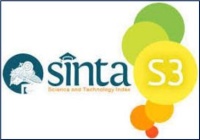Analysis of The Performance of Microbubble Generators as Aerators in Tilapia Cultivation with High Density Fishery Systems
Abstract
Keywords
Full Text:
PDFReferences
Azhari, A., Abidin, Z., Muchlisin, and Dewiyanti, I., 2017, Pengaruh padat tebar terhadap kelangsungan hidup dan pertumbuhan benih ikan seurukan (Osteochilus vittatus), Jurnal Ilmiah Mahasiswa Kelautan dan Perikanan Unsyiah. 12 – 19.
Boyd, C.E., 1998, Water Quality for Pond Aquaculture, Department of Fisheries and Allied Aquacultures, Aubunr University, Alabama
Dampin, N., Tarnchalanukit, W., Chunkao, K., and Maleewong, M., 2012, Fish Growth Model for Nile Tilapia (Oreochromis niloticus) in Wastewater Oxidation Pond, Thailand. Procedia Environmental Sciences, 13, 513 – 524
Diansari, R. R. V. R., Arini, E., and Elfitasari, T., 2013, Pengaruh kepadatan yang berbeda terhadap kelulushidupan dan pertumbuhan ikan nila (Oreochromis niloticus) pada sistem resirkulasi dengan filter Zeolit. Journal of Aquaculture Management and Technology. 2(1), 37 – 45
Heriyati, E., Rustadi, R., Isnansetyo, A., Triyatmo, B., Istiqomah, I., Deendarlianto, D., and Budhijanto, W., 2022, Microbubble Aeration in A Recirculating Aquaculture System (RAS) Increased Dissolved Oxygen, Fish Culture Performance, and Stress Resistance of Red Tilapia (Oreochromis sp.). Trends in Sciences, 19
Hertanto, M., A., 2013, Produksi ikan nila (Oreochromis niloticus) jantan menggunakan madu lebah hutan. Jurnal Bioteknologi Universitas Atmajaya Yogyakarta, 1 – 13.
Juwana, W. E., Widyatama, A., Majid, A. I., Budhijanto, W., Indarto, and Deendarlianto, 2018, The application of digital image analysis to study the characteristic of bubble size distribution produced by orifice type microbubble generator, Proc. Of the 9th International Conference on Thermofluids 2017.
Juwana, W. E., Widyatama, A., Dinaryanto, O., Budhijanto, W., Indarto, and Deendarlianto, 2019, “Hydrodynamic characteristics of the microbubble dissolution in liquid using orifice type microbubble generator”. Chemical Engineering Research and Design, 141(1)
Lakani, F. B., Sattari, M., and Falahatkar. B., 2013, Effect of Different Oxygen Levels on Growth Performance, Stress Response and Oxygen Consumption in 2 Weight Groups of Great Sturgeon Huso Huso. Iranian Journal of Fisheries Sciences, 12(1), 553-549.
Li, P., 2006, Dissertation: Development of Advanced Water Treatment Technology Using Microbubble, Kejo University.
Mallya, Y., J., 2007, The Effects of Dissolved Oxygen on Fish Growth in Aquaculture, Kingolwira National Fish Farming Centre, Fisheries Division Ministry of Naturan Resources and Tourism, Tanzania.
Mawarni, D. I., Juwana, W. E., Yuana, K. A., Budhijanto, W., Deendarlianto, and Indarto, 2022, “Hydrodynamic characteristics of the microbubble dissolution in liquid using the swirl flow type of microbubble generator”. Journal of Water Process Engineering. 48(1).
Pambudiarto, B. A., Mindaryani, A., Budhijanto, W., and Deendarlianto, 2020, Evaluation of the Effect of Operating Parameters on the Performance of Orifice/Porous Pipe Type Micro-bubble Generator, Journal of Engineering and Technological Sciences, 52(2)
Parmar, R., and Majumder, S., K., 2013, Micro-bubble generation and microbubble-aided transport intersection – A state of the art report -, Chemical Engineering and Process: Process Intensification, 64(1), 79 - 97
Perikanan, K., K., 2022, “No title”. https://www.kkp.go.id/ (accessed 28 Feb, 2024)
Ronald, N., Gladys, B., and Gasper, E., 2014, The Effects of Stocking Density on the Growth and Survival of Nile Tilapia (Oreochromis niloticus) Fry at Son Fish Farm. Journal of Aquaculture Research & Development.
Salsabila, M., and Suprapto, H., 2018, Enlargement Technique of Tilapia (Oreochromis niloticus) in Freshwater Aquaculture Installation Pandaan, East Java. Journal of Aquaculture and Fish Health, 7(3).
Susanto. H., 2000, Budi Daya Ikan di Pekarangan, Penebar Swadaya, Jakarta.
Wahyuningsih, S., and Gitarama, A. M., 2020, Amonia pada sistem budidaya ikan. Jurnal Ilmiah Indonesia. 5(1), 112 - 113
Wu, M., Song, H., Liang, X., Huang, N., and Li, X., 2022, Generation of micronano bubbles by self-developed swirl-type micro-nano bubble generator, Chemical Engineering and Processing – Process Intensification, Vol.181.
DOI: https://doi.org/10.33394/bioscientist.v12i2.13064
Refbacks
- There are currently no refbacks.

This work is licensed under a Creative Commons Attribution-ShareAlike 4.0 International License.

Bioscientist : Jurnal Ilmiah Biologi is licensed under a Creative Commons Attribution-ShareAlike 4.0 International License
Editorial Address: Pemuda Street No. 59A, Catur Building Floor I, Mataram City, West Nusa Tenggara Province, Indonesia











